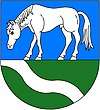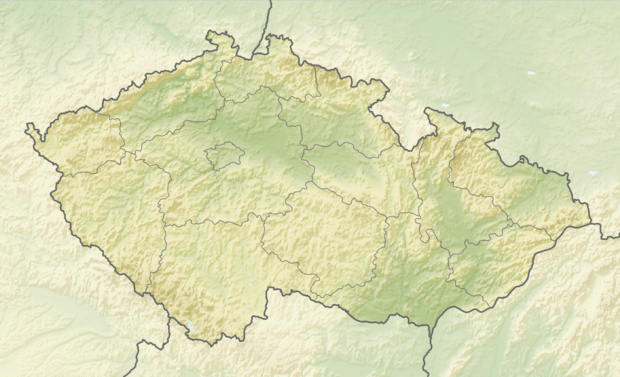Hranice (Cheb District)
Hranice (German: Roßbach) is a border town in Cheb District in the Karlovy Vary Region of the Czech Republic. It has a population of about 2,100.
Hranice | |
|---|---|
Town | |
_aerial_view_2008-07-01.jpg) Aerial view of Hranice | |
 Flag  Coat of arms | |
 Hranice Location in the Czech Republic | |
| Coordinates: 50°18′17″N 12°10′33″E | |
| Country | |
| Region | Karlovy Vary |
| District | Cheb |
| First mentioned | 1413 |
| Government | |
| • Mayor | Daniel Mašlár |
| Area | |
| • Total | 31.80 km2 (12.28 sq mi) |
| Elevation | 575 m (1,886 ft) |
| Population (2020-01-01[1]) | |
| • Total | 2,147 |
| • Density | 68/km2 (170/sq mi) |
| Time zone | UTC+1 (CET) |
| • Summer (DST) | UTC+2 (CEST) |
| Postal code | 351 24 |
| Website | www |
Etymology
In Czech, Hranice means "border". The old German name, Rossbach, means "horse brook". Following the partition of Germany, a border tripoint (between Czechoslovakia, West and East Germany) was situated near the town, for which the village of Trojmezí (literally "Tripoint") is named. In fact, the village is also the tripoint of the three historical regions of Bohemia, Bavaria and Saxony.
Geography
Hranice lies twelve kilometres north of Aš, in the northernmost part of the region, at about 575 meters above sea level. The villages of Trojmezí and Kozí Hřbety to the west of the town, Krásňany to the east, Pastviny to the southwest, and Studánka and Novosedly to the south are parts of Hranice. It neighbors the German towns of Bad Elster to the southeast, Gettengrün to the northeast, and Ebmath to the north.
The municipality of Hranice, besides Hranice proper, includes villages of Pastviny, Studánka and Trojmezí.
History
The first written mention of Hranice dates to 1413, when the town was bought by the House of Zedtwitz. Before that time, Hranice was the property of the Neubergs. At the end of the 14th century, the Neubergs ran into financial trouble and sold the town. The House of Zedwitz controlled Hranice and the whole region around Aš for almost 500 years.
In 1542, Lutheranism first appeared in the village.
In 1633, the bubonic plague killed forty people in the town.
In 1822 a new school was built; in 1850, a post office was opened; and in 1868, the first fire squad was established.
Textile industry
In the 19th century, the textile industry expanded rapidly in the region, including in Hranice. Beginning in 1806, a local textile factory was one of the most successful in Bohemia. In 1840, however, a plan to build a new road through the town was rejected by the local council. Because Hranice had no railway connection and only bad roads, the textile industry there began to decline. Two new railway routes – one from Aš to Hranice (established in 1885) and the other from Hranice to Adorf (established in 1906) – helped local industry greatly.
Landmarks
Buildings
Notable buildings in Hranice include the Evangelic Church, built in the 14th century, and the Catholic Church of the Virgin Mary, built in 1894.
Memorials
Hranice contains a World War I memorial, built in 1928, along with a World War II memorial and a memorial to a Royal Air Force pilot who crashed in the area during World War II.
Notable people
- Johann Christoph Hilf (1783–1885), musician
- Josef Hendel (1897–1993), artist in multiple fields
- Rudolf Dölling (1902–1975), major general of the National People's Army in the German Democratic Republic and ambassador to the Soviet Union
- Otto Zapf (born 1931), industrial designer, co-founder of the furniture manufacturer Vitsoe
Gallery
_evangelic_church_2009-07-08.jpg) Protestant church
Protestant church_WW1_Memorial_2008-05-25.jpg) WW1 memorial
WW1 memorial Train station
Train station
References
- "Population of Municipalities – 1 January 2020". Czech Statistical Office. 2020-04-30.